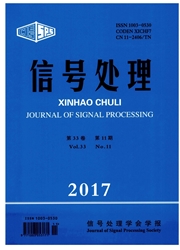

 中文摘要:
中文摘要:
介质访问控制协议(Medium Access Control,MAC)是水声通信网络中的一种关键技术。与陆地无线通信系统使用无线电波有所不同,水声通信网络依靠水声进行通信。由于水声信道的传播时延长、可用带宽有限,使得设计适合于水声通信网络的MAC协议面临诸多困难。然而,水声信道的长传播时延特性允许在水声信道中同时发送多个数据包,利用该特性,基于MACA协议,本文提出了一种适用于水声通信网络的介质访问控制协议,MACA-C协议。通过将发射数据包和控制包结合在一起,本文提出的协议能够克服水声信道长传输时延的问题。仿真结果表明,MACA-C协议能够提高信道使用率,获得较高且稳定的吞吐量,降低端到端的延迟,并且保持较低的碰撞率。
 英文摘要:
英文摘要:
Medium access control (MAC) protocol is a key technology for underwater acoustic communication network (UACN). Unlike terrestrial wireless communication which uses radio waves, UACN relies on acoustic waves to communicate. The long propagation delay and limited bandwidth of UACN pose great challenges for MAC protocol design. But the long propagation delay in underwater acoustic channel permits multiple packets to be "pipelined" concurrently in the underwater channel. To utilize this characteristic of underwater acoustic channel, in this paper we propose a new MACA-based MAC protocol called MACA-C protocol. By combining transmitting data packet and control packet, the proposed protocol is able to overcome the long propagation delay problem of underwater acoustic channel. Simulation results show that the MACA-C protocol significantly increase channel utilization, achieve high and stable throughput performance, decrease Endto-End delay while maintaining low collision rate.
 同期刊论文项目
同期刊论文项目
 同项目期刊论文
同项目期刊论文
 Chaos synchronization of fractional order time-delay Chen system and its application in secure commu
Chaos synchronization of fractional order time-delay Chen system and its application in secure commu Sound Source Localization of Digital Hearing Aids Using Wavelet Based Multivariate Statistical Metho
Sound Source Localization of Digital Hearing Aids Using Wavelet Based Multivariate Statistical Metho Acoustic feedback cancellation based on weighted adaptive projection subgradient method in hearing a
Acoustic feedback cancellation based on weighted adaptive projection subgradient method in hearing a Blind Multiple Access Interference Suppression Algorithm Based on Relaxed Subgradient Projection for
Blind Multiple Access Interference Suppression Algorithm Based on Relaxed Subgradient Projection for Two-dimensional canonical correlation analysis and its application in small sample size face recogni
Two-dimensional canonical correlation analysis and its application in small sample size face recogni 期刊信息
期刊信息
